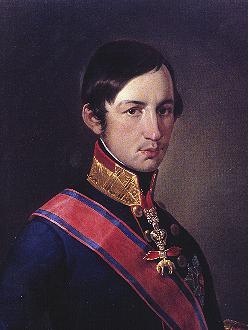 |
 |
 |
 |
 |
 |
 |
 |
 |
Francis I
Francesco Ferdinando Geminiano von Habsburg-Lothringen was born at Modena in central Italy, June 1, 1819. He was the elder son of Duke Francis IV of Modena, Archduke of Austria, and of his wife, Princess Mary Beatrice of Savoy. From his birth Francis bore the titles of "Hereditary Prince of Modena, Archduke of Austria-Este, and Prince of Hungary and Bohemia". Five days after his birth, on Trinity Sunday, the prince was baptised by the Archbishop of Modena in the Cathedral of the city; the Archduke Ferdinand, uncle to the prince, acted as proxy for the godfather, the Emperor Francis I of Austria (formerly Holy Roman Emperor). At the death of his grandfather Victor Emanuel, January 10, 1824, Francis' mother Mary Beatrice succeeded to all of her father's British rights. Francis was henceforward recognised by the Jacobites as "The Prince Francis of England, Scotland, France, and Ireland, Duke of Cornwall and Rothesay, Earl of Carrick, Baron of Renfrew, Lord of the Isles, and Prince and Great Steward of Scotland". He was the first prince to have a right to the titles of Duke of Cornwall and Rothesay since the succession of Prince Charles Edward to the throne in 1766. In 1826 Duke Francis IV of Modena appointed as tutor for his son Count Clemente Coronini, assisted by Don Pietro Raffaelli (later Bishop of Carpi and Reggio). In 1829 Baron Ernest Geramb took over as tutor. At the death of his mother Mary Beatrice, September 15, 1840, Francis succeeded to all of her British rights. He was henceforward recognised by the Jacobites as "King Francis I". On March 30, 1842, at the Munich Residenz in the Allerheiligenhofkirche, Francis married Princess Adelgunde of Bavaria, third daughter of King Ludwig I of Bavaria and of his wife, Princess Therese of Saxe-Hildburghausen. The Archbishop of Munich-Freising was the chief witness. The couple were blessed with only one child, The Princess Anna Beatrice, who was born October 19, 1848, and died July 8, 1849. At the death of his father Duke Francis IV of Modena, January 21, 1846, Francis succeeded as Duke Francis V of Modena; he also bore the titles of Duke of Reggio and Mirandola, Duke of Massa, Prince of Carrara and Lunigiana. At the death of his cousin the Empress Marie-Louise, December 18, 1847, he succeeded as Duke of Guastalla. Francis was named a Knight of the (Austrian) Order of the Golden Fleece, September 15, 1836. In 1839 he received the Grand Cordon of the (Dutch) Order of the Lion, and in 1842 the (Savoy) Supreme Order of the Most Holy Annunciation. In 1855 Francis established the Order of the Eagle of Este of which he was Grand Master. In 1859 Modena was attacked by the armies of Piedmont and France. On June 14,1859, Francis withdrew from his duchy. On March 18, 1860, by decree of King Victor Emanuel II of Sardinia, Francis' duchies were de facto incorporated into the new kingdom of Italy; Francis protested this action, March 22, 1860. A year later, on March 7, 1861, Francis was the object of a verbal attack in the House of Commons by William Ewart Gladstone, at the time de facto Chancellor of the Exchequer. The charges made against Francis were shown to be absolutely false by Lord Derby and by Constantine Phipps, called Marquis of Normanby. After 1860 Francis retired to Vienna in Austria where he lived in the Palais Modena. He also maintained a summer residence in Bavaria at Schloss Wildenwart. He travelled a great deal, including a major trip to the Middle East in 1864. Francis died at Vienna, November 20, 1875, when he was succeeded in his British rights by his niece, Mary Theresa. His remains lie in the Capuchin Church in Vienna.
This page is maintained by Noel S. McFerran (noel.mcferran@rogers.com) and was last updated June 26, 2010. © Noel S. McFerran 1997-2010. |
